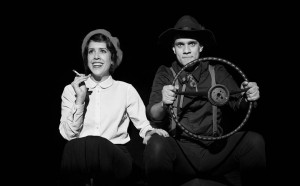nicole power as bonnie & adrian yearwood as clyde
Echo Productions’ Bonnie and Clyde, which plays until March 14, 2015 at the Factory Studio Theatre, is an ambitious undertaking that brings together vivid dance and stylized movement and a more conventional narrative rooted in flashbacks to tell the tale of two of America’s most famous outlaws. It is a piece that has moments that are quite captivating, but lacks a unifying concept that will sturdily bring all these elements together into the same play.
In the Programme notes it states that Bonnie and Clyde’s “lives have been so sensationalized in popular culture over the eighty years since their deaths that it is sometimes difficult to remember that these were two real people who led real, desperate and tragically short, lives.” Indeed, Adrian Yearwood’s play seems to focus on how ordinary Bonnie Parker and Clyde Barrow are. Here, they are incredibly nice, loving, supportive, agreeable and loyal to their friends and families. They are emotional- often moved to tears in grief as the body count climbs and Clyde oscillates between trying to blame his troubles on a vague sense of being a victim (unable to keep a job because of his prior run-ins with the law) and guilt and remorse at the shame he has inflicted on his long-suffering Mama. The problem, of course, is that it doesn’t make any sense why someone who is so sweet and loving, from a wholesome family who make hot chocolate together, who is in love with a girl who just wants to go to the movies, is killing innocent people unprovoked on a spree across several States. This portrayal doesn’t make us empathize with Clyde, it just makes him seem either chronically underdeveloped as a character or whiney and foolish.
In fact, the truth of Clyde Barrow is much more interesting than this fiction allows. Theatre thrives on conflict, and here most of the readymade drama has been either watered down or removed completely. In fact, Barrow was steadily employed between 1927 and 1929, but that didn’t stop him from robbing stores, cracking safes and stealing cars. He smashed the skull of a fellow inmate with a lead pipe at Eastham Prison Farm because he alleged that prisoner had sexually assaulted him. According to Ralph Fults between the time Barrow was sent to prison and was released in 1932, he had changed from “a schoolboy to a rattlesnake.” Yearwood, who also plays Barrow, is goreat at creating this schoolboy, but the play would benefit from a clear escalation toward the skull-crushing rattlesnake. In this production Nicole Power’s Bonnie Parker often seems more callous and cold than Clyde. She exudes the power to manipulate and shows no fear, dependence or subservience to Clyde. This is an interesting choice that is worth exploring in further detail. How does this dynamic create conflict for the lovers and heighten the drama of an already intense crime spree? How does this dynamic rest with the slew of hardened criminals in Barrow’s gang, especially given the historical context of gender roles in the Great Depression? Meghan Greeley gives a nuanced performance as Clyde’s sister in law, Blanche, who also gets roped into the gang and ends up being interrogated in prison while Bonnie and Clyde are still at large. Yet, again, I felt that their treatment of a blind, young woman being interrogated under such circumstances was much too kind, and I also wondered what other horrors she was being subjected to at the hands of the guards and other inmates and how that may have further informed the growth of her character over time. I encourage Yearwood to delve deeply into the darkest crevices of his imagination and the research into these people’s lives and to not be afraid to shine the light on the most disturbing and harrowing aspects of this story.
The most captivating aspect of Bonnie and Clyde is the dancing performed by “The Law” (Emma Bartolomucci, Robyn Noftall, Rory Bray, Margaret Thompson and Rebecca Sadowski) and choreographed by Bartolomucci. The Law continually encircles the Barrow gang, unseen- it is even woven into the geography and architecture of the towns- The Law are doorways and tables- they are inherent in the fabric of American life and thus, there can be no escape for Bonnie and Clyde. At some point the Law will find them and “justice” will prevail. The dancing is magnetic, fierce and proficient, especially at the end of the First Act, when it beautifully captures the violent and lethal clash between the gang and the law. There is room here for director Victoria Fuller to tighten up the connection between the stylized Law dancers and the rest of the piece, which is rooted in Realism. I would also encourage Fuller and Yearwood to ask themselves why this story of Bonnie and Clyde needs to be told to a Torontonian audience in 2015? The answers likely will help them find a stronger unifying concept.
Bonnie and Clyde is a bumpy journey, but it has moments in the writing, the acting, the choreography and lightning design that shine with clear promise. There is absolutely a play in here, and I hope these artists will keep honing at it and delving more ardently into the depths of these characters and the complexities and contradictions in them and their world so it can speak to us, not just as a relic in a museum, but with all the urgency of the present.
Bonnie and Clyde is closed.







 World Theatre Day: My God Is It Ever The Time to Invest in Canadian Plays
World Theatre Day: My God Is It Ever The Time to Invest in Canadian Plays 